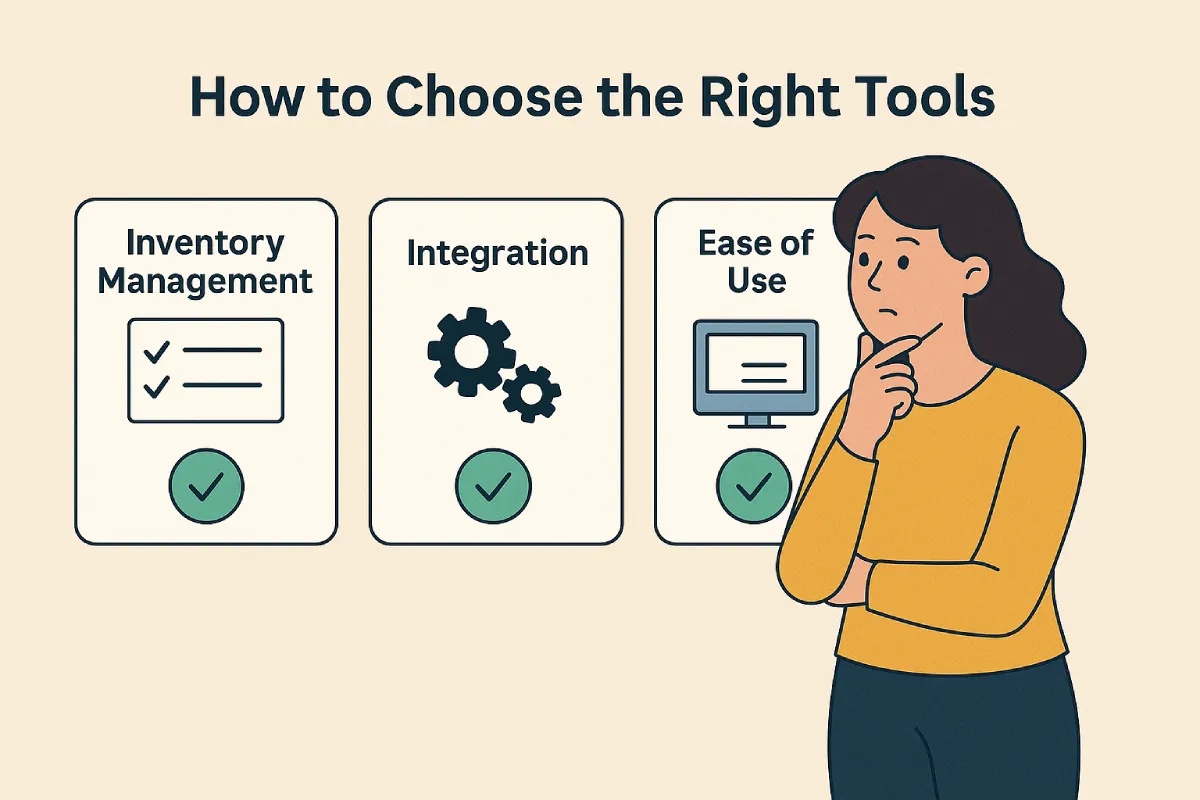How to Streamline Your E-commerce Workflows With Smart Backend Tools
Running an e-commerce business takes a lot of work. Between updating inventory, processing orders, handling customer emails, and tracking expenses, it can feel like there are never enough hours in the day. Many store owners find themselves stuck in the details instead of focusing on growth.
The problem is that manual tasks eat up time and energy. They also leave plenty of room for mistakes, like overselling products or missing a shipment deadline. These small errors can add up to lost sales and frustrated customers.
Smart backend tools are designed to fix that. They automate repetitive work, keep information updated across platforms, and connect the different parts of your business so they run together smoothly. Instead of spending hours on spreadsheets and emails, you can rely on systems that handle much of it for you.
In this article, we’ll look at how the right tools can save time, reduce errors, and make your e-commerce operations more manageable.
Why Backend Workflows Matter
Behind every online store, there are tasks that customers never see. These are the backend workflows, the systems, and processes that keep the shop running. They include updating inventory, processing orders, managing shipping, handling payments, and keeping customer data organized.
When these workflows run smoothly, the business feels easier to manage. Orders get shipped on time, stock counts stay accurate, and customers receive the right information without delay. But when the backend is messy, problems show up quickly. A missed update can lead to late shipments, and disconnected systems can cause errors that frustrate buyers.
Imagine a store that sells a limited-edition product. The website says five are left, but the inventory hasn’t updated in real time. Ten customers place an order before the store owner notices. Half of those buyers are told later that the item is out of stock, leaving them disappointed and unlikely to return.
Efficient backend workflows prevent situations like this, helping businesses stay reliable and customers stay happy.
The Pain Points of Manual Workflows
Running e-commerce operations by hand might work at the very beginning, but it quickly becomes overwhelming. The more products and customers you have, the more time gets eaten up by repetitive tasks.
One of the biggest struggles is tracking inventory in spreadsheets. It’s easy to lose track of what’s in stock, especially when sales are coming in from multiple channels. Manually updating product descriptions across platforms is another time sink. A simple change—like adjusting a price or adding new details—can take hours if it has to be copied over to several places.
Order fulfillment is another headache. Copying customer details into shipping labels one by one is slow, and the chance of mistakes is high. On top of that, customer service often means digging through a crowded inbox, trying to find the right email thread among dozens of messages.
For many business owners, weekends become catch-up time. Picture someone spending their Sunday afternoon buried in spreadsheets and paperwork instead of relaxing with family. It feels like the work never ends, and there’s little room left for planning new products or marketing strategies.
When time is tied up in manual work, it’s harder to focus on the bigger picture and the opportunities that could move the business forward.
What Smart Backend Tools Can Do
Smart backend tools are built to take these burdens off your plate. They are software solutions that automate tasks, connect systems, and make daily operations flow with less effort.
The biggest benefit is time. Instead of typing out the same information over and over, tools can update data automatically. This reduces errors, too. When inventory, orders, and shipping details sync across platforms, there’s less risk of mistakes that upset customers.
These tools also create smoother customer experiences. For example, when someone places an order, a tool can immediately update stock, generate a shipping label, and send a confirmation email. The buyer feels confident, and you don’t have to lift a finger.
For business owners, this shift means more space to focus on growth. Instead of worrying about whether the right email went out, you can spend time building new marketing campaigns, developing fresh products, or exploring sales channels.
Smart backend tools aren’t about replacing the human touch. They’re about creating a reliable system that supports your business behind the scenes.
Essential Tools to Consider
There are many different backend tools available, and the right mix depends on your needs. Here are some categories that can make a big difference.
Inventory Management Tools
These keep stock levels updated in real time. You can see what’s available, set alerts for low items, and avoid overselling. If a product is running low, you’ll know right away and can reorder before it’s too late.
Order and Shipping Automation
Tools that sync orders with shipping carriers save hours. They generate labels, update tracking numbers, and send confirmations automatically. A task that once took an afternoon can be done in minutes.
Customer Support Systems
Support platforms bring messages from email, chat, and social media into one place. They also offer features like canned replies or chatbots for common questions. This makes customers feel heard while freeing up your time.
Sales Pipeline Tools
Sales pipeline tools give you a clear picture of where customers are in their journey. You can track leads, manage follow-ups, and spot opportunities. For example, a wholesale inquiry won’t get lost in a crowded inbox because the system reminds you to respond.
Affiliate and Referral Program Tools
Referral and affiliate tools like Rewardful encourage customers and partners to share your products. They handle tracking, links, and commission payouts. With these in place, word-of-mouth marketing grows without extra effort from you.
Accounting and Finance Tools
These record sales, fees, and expenses automatically. They generate reports you’ll need for taxes and help you understand cash flow without digging through receipts.
Video and Team Collaboration Tools
If you work with a remote team, collaboration tools are a must. Video calls, file sharing, and project boards make it easier to stay connected. A weekly video check-in with a virtual assistant, for example, can replace dozens of scattered emails.
Analytics and Reporting
Reporting tools show you which products sell best, where your traffic comes from, and what customers respond to. With this information, you can make decisions based on data, not just guesswork.
How to Choose the Right Tools
With so many options out there, choosing tools can feel overwhelming. The best approach is to start with your biggest pain point. If inventory management is causing the most stress, begin there. Once that’s under control, move on to shipping or customer support.
Integration is another key factor. Look for tools that work smoothly with your e-commerce platform. A simple, easy-to-use interface is better than one packed with features you’ll never use.
Finally, don’t feel pressured to adopt everything at once. Test one tool, see how it helps, and then add another. A gradual approach makes the transition easier and helps you see what’s truly useful for your business.
Setting Up Smart Workflows
Once you’ve chosen your tools, the goal is to connect them so tasks flow from one step to the next.
Here’s a simple example:
- A customer places an order on your site.
- The inventory tool updates stock automatically.
- A shipping label is created, and the tracking number is sent to the customer.
- The sale is recorded in your accounting tool.
- A confirmation email goes out, giving the buyer peace of mind.
When everything is linked, the workflow runs in the background. The business feels lighter because you don’t have to manage every detail manually. Instead of dreading the daily grind, you can check in quickly and know things are running as they should.
Overcoming Common Fears
It’s natural to feel hesitant about switching to new systems. Many owners worry about cost, complexity, or losing control.
The good news is that most tools are designed to scale with your business. You can often start with free or low-cost plans and upgrade as you grow. Most platforms are also built with beginners in mind, with guides and support to help you learn.
And while automation handles repetitive work, it doesn’t take away your oversight. You can still check in, approve orders, or review reports anytime you want.
One shop owner I spoke to was nervous about letting go of spreadsheets. After a week of using inventory software, she admitted she wished she had done it sooner. What seemed intimidating at first turned out to be simple and freeing.
Conclusion
E-commerce is exciting, but it can also be exhausting when you’re trying to do everything by hand. Manual workflows leave you buried in details and make it harder to grow.
Smart backend tools change that. They automate tasks, keep systems connected, and give you more time to focus on the parts of your business that inspire you. Whether it’s inventory management, order fulfillment, or customer support, there’s a tool that can make life easier.
You don’t have to overhaul everything overnight. Start small, solve one bottleneck, and build from there. Soon, you’ll find yourself spending less time on busywork and more time shaping the future of your business.



Leave a Reply